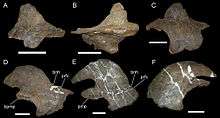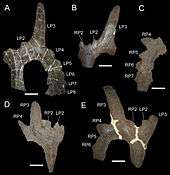Einiosaurus
| Einiosaurus Temporal range: Upper Cretaceous, 74.5–74 Ma | |
|---|---|
 | |
| Reconstructed skull, Los Angeles Natural History Museum | |
| Scientific classification | |
| Kingdom: | Animalia |
| Phylum: | Chordata |
| Class: | Reptilia |
| Clade: | Dinosauria |
| Order: | †Ornithischia |
| Family: | †Ceratopsidae |
| Tribe: | †Pachyrhinosaurini |
| Genus: | †Einiosaurus Sampson, 1995 |
| Species: | †E. procurvicornis |
| Binomial name | |
| Einiosaurus procurvicornis Sampson, 1995 | |
Einiosaurus is a medium-sized herbivorous centrosaurine ceratopsian dinosaur from the Upper Cretaceous (Campanian stage) of northwestern Montana. The name means 'buffalo lizard', in a combination of Blackfeet Indian eini and Latinized Ancient Greek sauros; the specific name (procurvicornis) means 'with a forward-curving horn' in Latin.
Description

Einiosaurus was a herbivorous dinosaur. In 2010 Gregory S. Paul estimated its body length at 4.5 metres, its weight at 1.3 tonnes.[1] Its snout is narrow and very pointed. It is typically portrayed with a low, strongly forward and downward curving nasal horn that resembles a bottle opener, though this may only occur in some adults. The supraorbital (over-the-eye) horns are low, short and triangular in top view if present at all, as opposed to the chasmosaurines, such as Triceratops, which have prominent supraorbital horns. A pair of large spikes, the third epiparietals, projects backwards from the relatively small frill. Smaller osteoderms adorn the frill edge. The first epiparietals are largely absent.
Paleobiology
Low-diversity and single-species bonebeds are thought to represent herds that may have died in catastrophic events, such as during a drought or flood. This is evidence that Einiosaurus, as well as other centrosaurine ceratopsians such as Pachyrhinosaurus and Centrosaurus, were herding animals similar in behavior to modern-day bison or wildebeest. In contrast, ceratopsine ceratopsids, such as Triceratops and Torosaurus, are typically found singly, implying that they may have been somewhat solitary in life, though fossilized footprints may provide evidence to the contrary.[2] In 2010, a study by Julie Reizner of the individuals excavated at the Dino Ridge site concluded that Einiosaurus grew quickly until its third to fifth year of life after which growth slowed, probably at the onset of sexual maturity.[3]

Like all ceratopsids, Einiosaurus had a complex dental battery capable of processing even the toughest plants.[4] Einiosaurus lived in an inland habitat.[5]
Einiosaurus fossils are found in the upper part of the Two Medicine Formation of Montana, dating to the mid-late Campanian stage of the late Cretaceous Period, about 74.5 million years ago.[6][7] Dinosaurs that lived alongside Einiosaurus include the basal ornithopod Orodromeus, hadrosaurids (such as Hypacrosaurus, Maiasaura, and Prosaurolophus), the ankylosaurs Edmontonia and Euoplocephalus, the tyrannosaurid Daspletosaurus (which appears to have been a specialist of preying on ceratopsians), as well as the smaller theropods Bambiraptor, Chirostenotes, Troodon, and Avisaurus. Einiosaurus lived in a climate that was seasonal, warm, and semi-arid. Other fossils found with the Einiosaurus material include freshwater bivalves and gastropods, which imply that these bones were deposited in a shallow lake environment.
History of discovery

Einiosaurus is an exclusively Montanan dinosaur, and all its known remains are currently held at the Museum of the Rockies in Bozeman, Montana. At least fifteen individuals of varying ages are represented by three adult skulls and hundreds of other bones from two low-diversity (one species) bonebeds, which were discovered by Jack Horner in 1985 and excavated from 1985-1989 by Museum of the Rockies field crews. These bonebeds were originally thought to contain a new species of Styracosaurus and are referred to as such in the comprehensive taphonomic study by Ray Rogers from 1990.[2] The same year Stephen Czerkas published the name Styracosaurus makeli, honouring Robert Makela, but without description so that it remained an invalid nomen nudum.[8] In 1992 Horner discerned three species in the material from the bonebeds in this region, that he indicated as Type A, B and C.[9] In 1995 Scott D. Sampson formally described and named Type B as the type species Einiosaurus procurvicornis; in the same article he named Type C as Achelousaurus horneri. The holotype of Einiosaurus is MOR 456.[10]
In 2010 Paul renamed E. procurvicornis into Centrosaurus procurvicornis,[1] but this has found no acceptance.
Classification

The placement of Einiosaurus within Centrosaurinae is problematic due to the transitional nature of several of its skull characters, and its closest relatives are either Centrosaurus and Styracosaurus or Achelousaurus and Pachyrhinosaurus. The latter hypothesis is supported by Horner and colleagues, where Einiosaurus is the earliest of an evolutionary series in which the nasal horns gradually change to rough bosses, as in Achelousaurus and Pachyrhinosaurus which are the second and third in this series. The frills also grow in complexity.[9]
Regardless of which hypothesis is correct, Einiosaurus appears to occupy an intermediate position with respect to the evolution of the centrosaurines.
The cladogram presented here follows a 2012 phylogenetic analysis by Ryan, Evans & Shepherd.[11] Clade names within Centrosaurinae follow Fiorillo & Tykoski (2012).[12]
| Ceratopsidae |
| ||||||||||||||||||||||||||||||||||||||||||||||||||||||||||||||||||||||||||||||||||||
| |
See also
Footnotes
- 1 2 Paul, G.S., 2010, The Princeton Field Guide to Dinosaurs, Princeton University Press p. 262
- 1 2 Rogers (1990).
- ↑ Reizner, J., 2010, An ontogenetic series and population histology of the ceratopsid dinosaur Einiosaurus procurvicornis. Montana State University master’s thesis, pp 97
- ↑ Dodson, et al. (2004).
- ↑ "Judithian Climax," Lehman (2001); page 315.
- ↑ Andrew T. McDonald & John R. Horner, (2010). "New Material of "Styracosaurus" ovatus from the Two Medicine Formation of Montana". Pages 156–168 in: Michael J. Ryan, Brenda J. Chinnery-Allgeier, and David A. Eberth (eds), New Perspectives on Horned Dinosaurs: The Royal Tyrrell Museum Ceratopsian Symposium, Indiana University Press, Bloomington and Indianapolis, IN.
- ↑ Fiorillo, A.R. and Tykoski, R.S.T. (in press). "A new species of the centrosaurine ceratopsid Pachyrhinosaurus from the North Slope (Prince Creek Formation: Maastrichtian) of Alaska." Acta Palaeontologica Polonica, available online 26 Aug 2011. doi:10.4202/app.2011.0033
- ↑ Czerkas, S.J. & Czerkas, S.A., 1990, Dinosaurs. a Global View, Dragons’ World, 247 pp
- 1 2 Horner, et al. (1992).
- ↑ Sampson (1995).
- ↑ Ryan, M. J.; Evans, D. C.; Shepherd, K. M.; Sues, H. (2012). "A new ceratopsid from the Foremost Formation (middle Campanian) of Alberta". Canadian Journal of Earth Sciences. 49 (10): 1251. doi:10.1139/e2012-056.
- ↑ Fiorillo, A. R.; Tykoski, R. S. (2012). "A new Maastrichtian species of the centrosaurine ceratopsid Pachyrhinosaurus from the North Slope of Alaska". Acta Palaeontologica Polonica. 57 (3): 561. doi:10.4202/app.2011.0033.
References
- Dodson, P., Forster, C.A. and Sampson, S.D. (2004). "Ceratopsidae." In, Weishampel, D.B., Dodson, P., and Osmolska, H. (eds.), The Dinosauria. 2nd Edition, University of California Press.
- Horner, J.R.; Varricchio, D.J.; Goodwin, M.J. (1992). "Marine transgressions and the evolution of Cretaceous dinosaurs". Nature. 358 (6381): 59–61. doi:10.1038/358059a0.
- Lehman, T. M., 2001, Late Cretaceous dinosaur provinciality: In: Mesozoic Vertebrate Life, edited by Tanke, D. H., and Carpenter, K., Indiana University Press, pp. 310–328.
- Rogers, R.R. (1990). "Taphonomy of three dinosaur bone beds in the Upper Cretaceous Two Medicine Formation of northwestern Montana: evidence for drought-related mortality". PALAIOS. 5 (5): 394–413. doi:10.2307/3514834. JSTOR 3514834.
- Sampson, S.D. (1995). "Two new horned dinosaurs from the Upper Cretaceous Two Medicine Formation of Montana; with a phylogenetic analysis of the Centrosaurinae (Ornithischia: Ceratopsidae)". Journal of Vertebrate Paleontology. 15 (4): 743–760. doi:10.1080/02724634.1995.10011259.
External links
- Einiosaurus at The Dinosaur Picture Database


